We tested recipes from these new cookbooks so you don’t have to
In a new series testing out cookbooks so you don’t have to, Olivia Campbell tries out a recipe from the gods, traces the history of nutmeg and turns that tin of beans in the back of the cupboard into a gourmet dinner

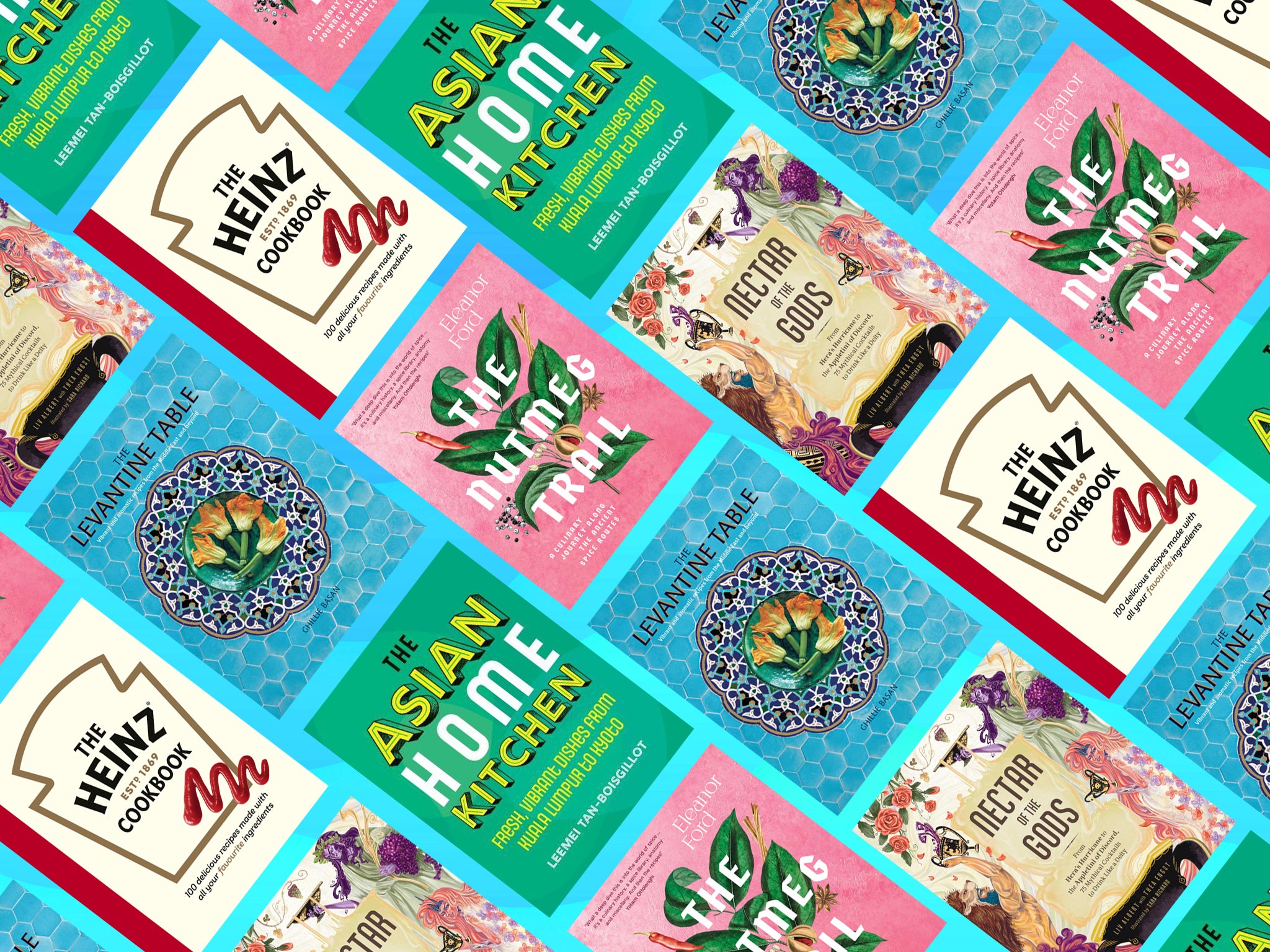
Buying cookbooks can be hard. Whether it’s the endless choice but no idea what you’re looking for, or not knowing if you want to hand over £30 for a single book.
IndyEats is launching a new series testing out the best cookbooks on shelves right now so you can decide if it’s the right publication to splurge on.
Nectar of the Gods by Liv Albert and Thea Engst

Shake your psykters and grab your kylikes, it’s time to party like it’s 999BC. Part history lesson, part guide to the booziest of cocktails, Nectar of the Gods is a wonderful collection of tipples inspired by the many magical figures in Greek mythology. The book, created by Liv Albert, the host of Let’s Talk About Myths, Baby!, and cocktail writer Thea Engst, is also beautifully illustrated.
The amount of cocktail recipes in this book is immense – from fun takes on classics (Eros on the Beach, anyone?), to niche and widely inventive tipples inspired by the gods and goddesses themselves. There’s also a handy guide for making mixers and syrups that will make your drinks more dynamic.
We decided to go for a Thalassea Breeze, a fruity cocktail inspired by Mother Ocean herself, Thalassa of the sea. Made up of vodka, grapefruit liqueur, cranberry juice, lime and sugar water, the drink is a complex mix of bitter and sweet. We had a great time sipping and were more than happy to make a grand total of 10 glasses…
The only less than ideal aspect of Nectar of the Gods is that the recipes use imperial measurements, which made the first few batches slightly harder to make and also led to a heated debate about whether cups work for measuring (they don’t – you can fight me). Also, quite a few of the cocktails use niche and/or multiple ingredients – we calculated the cost of one particular tipple and it would set us back a hefty £60. However, the authors do acknowledge this and suggest multiple alternatives at the beginning of the book.
Overall, you don’t have to be a foodie obsessed with Greek history to enjoy this book. Pick up a copy and hold a boozy party worthy of the gods.
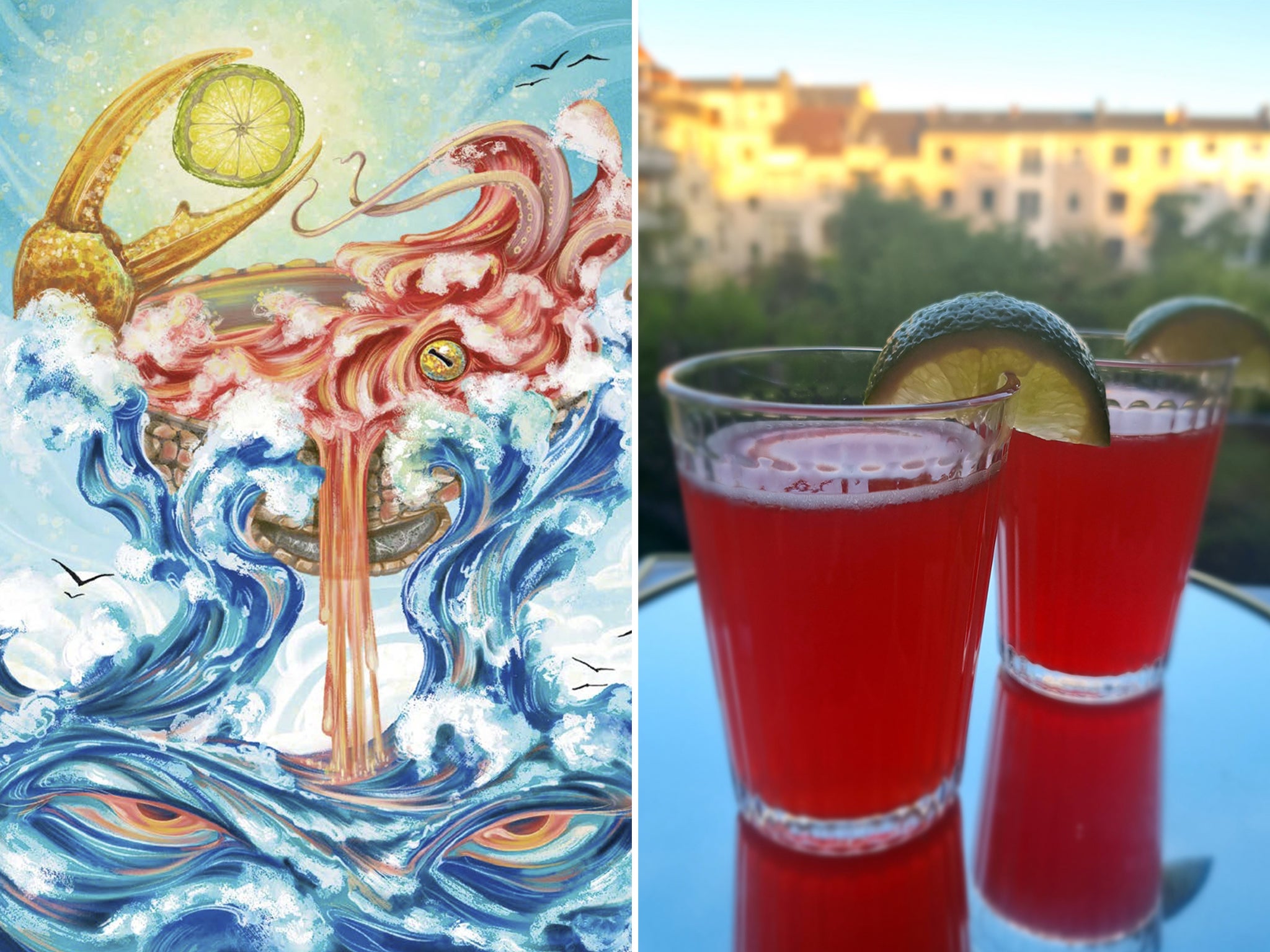
Ingredients:
2oz (60ml) cranberry juice
1½oz (44ml) vodka
¾oz (22ml) grapefruit liqueur
½oz (15ml) lime juice
½oz (15ml) Simple Syrup (see recipe in Part 1)
1 fresh lime wheel, scored
Ideally while overlooking the sparkling Mediterranean Thalassea, add all the ingredients except the lime wheel to a shaker with ice. Shake like you’re luxuriating on a boat, bobbing on the rolling waves. Strain over a king cube in your dolphin-painted kylix (a rocks glass). Garnish with the lime wheel on the rim and sip as you give thanks to Thalassa for all the beauty and bounty of the sea.
The Nutmeg Trail by Eleanor Ford
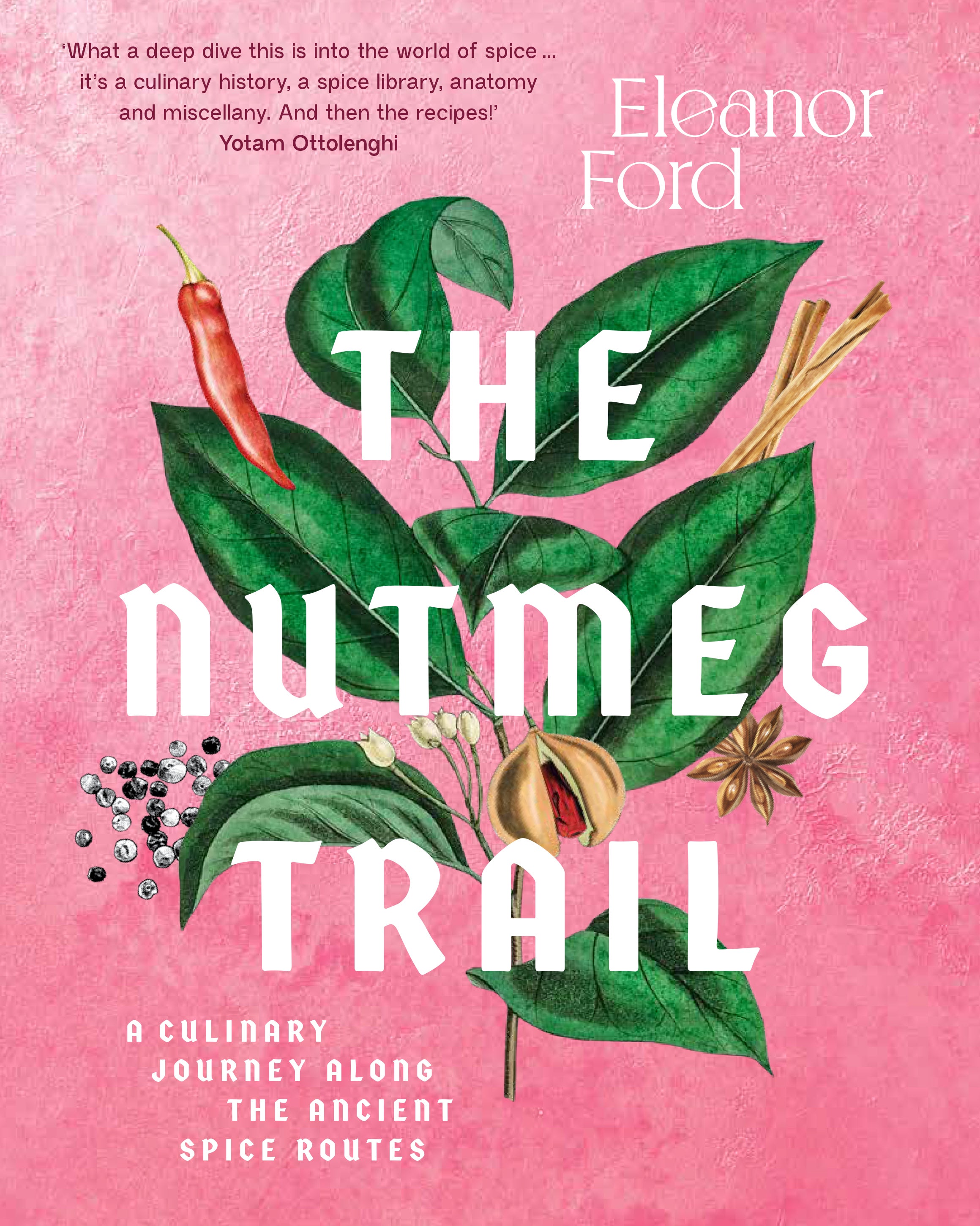
If the bold pink cover isn’t enough to attract you to this book, then the breadth of recipes in The Nutmeg Trail, created by food writer Eleanor Ford, should do the trick. Although the tumultuous history of nutmeg is a key part, the book focuses on centuries of the spice trade and the many dishes that have come about because of it.
You’re likely to have most of the ingredients in your cupboard, but perhaps not the knowledge or historical context of said ingredients. The Nutmeg Trail is a treasure trove of information, from spice pairings to clever techniques that will bring your food to life. The recipes are also not bound to one cuisine – if it could be found along ancient sea-based trade routes, it’s in this book.
We had a hard time trying to pick a recipe – we wanted to recreate everything! We eventually settled on two: green coconut hot sauce and rica rica prawns. The first one is a Somali recipe while the second is adapted from an Indonesian dish and it’s safe to say that our dinner that night was delicious. Both dishes were hot – I wouldn’t recommend if you can’t handle spice! However, the addition of lime helped add a refreshing element to both dishes. We paired the prawns with rice, as suggested in the cookbook, while the hot sauce was used as a condiment and sauce base for a green halloumi wrap – both delicious!
The recipes are divided into seven sections roughly based on different ingredients: ginger; peppercorns; petals and barks; chillies; lime leaves and lemongrass; cumin and coriander; spice blends. There’s no fancy ingredients – just recipes that celebrate food and the complex cultural heritage of a nation’s favourite dishes. If the immense amount of knowledge still isn’t enough, the cookbook is beautifully illustrated as well.
Rica rica prawns
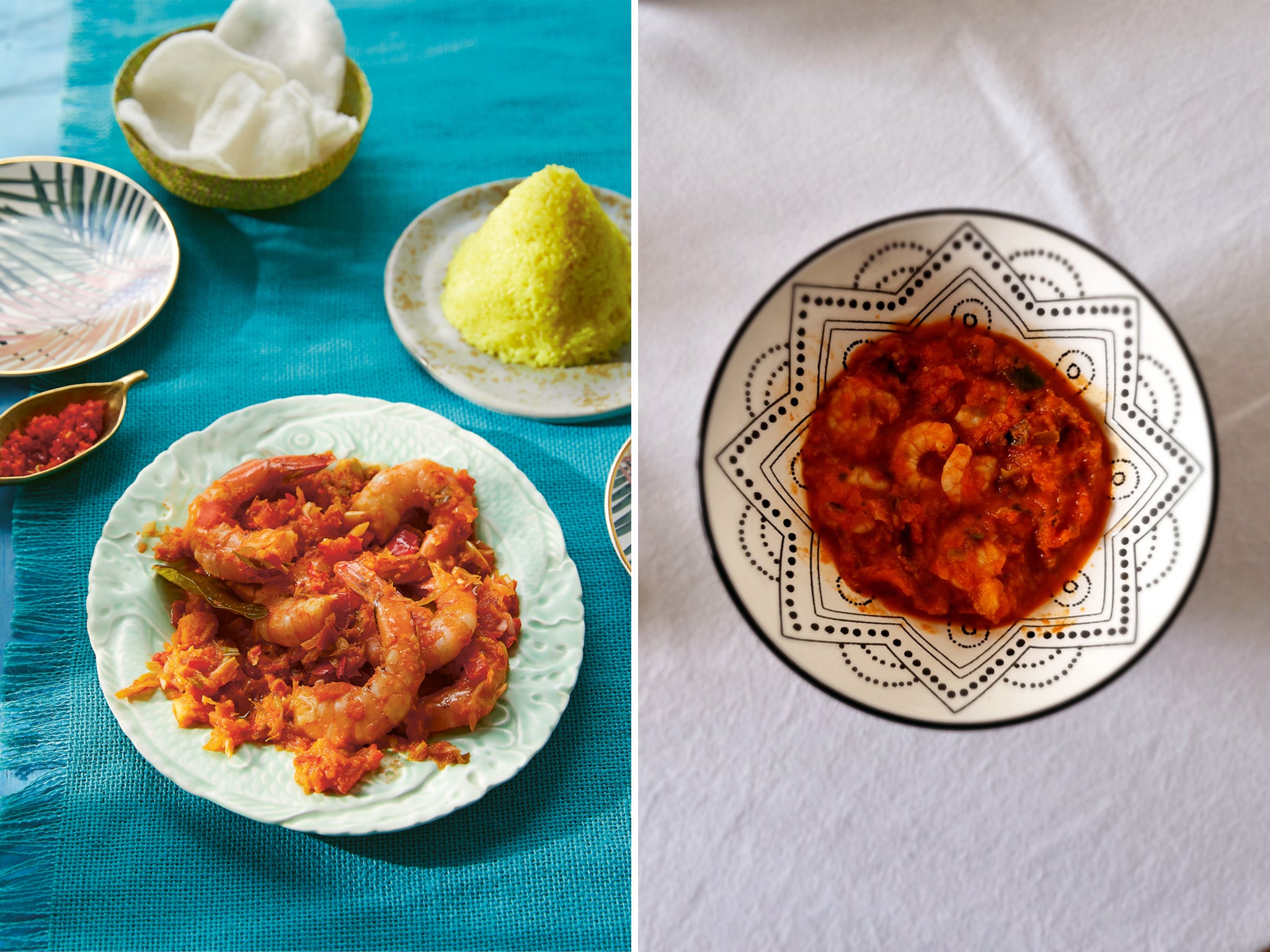
Ingredients:
2 tbsp neutral oil
3 tomatoes, chopped
100g (3½oz) spring onions (scallions), chopped
4 lime leaves, vein removed
½ tsp sugar
360g (13oz) raw peeled prawns, tails intact
Squeeze of lime
For the spice paste:
5 large red chillies, seeds removed
1-4 bird’s eye chillies, seeds in (optional)
4 small shallots
4 garlic cloves
5cm (2in) ginger, peeled
½ tsp fine sea salt
Juice of a lime
Method:
Roughly chop the aromatics for the spice paste and blitz all the ingredients together in a blender to a rough paste.
Heat the oil in a frying pan or wok and scrape in the spice paste. Fry on medium heat, stirring often, until it is sweetly fragrant and the harsh, raw edge has gone. Stir in the tomato, spring onion, lime leaves and sugar and cook so the tomato starts to break down into a sauce.
Add the prawns and simmer for about 5 minutes, until they lose their glassiness and are just cooked through and pink. Spritz in some lime juice and taste to see if any of the flavours need balancing – add more lime to brighten, or sugar and salt as needed. Serve at once.
Green coconut hot sauce
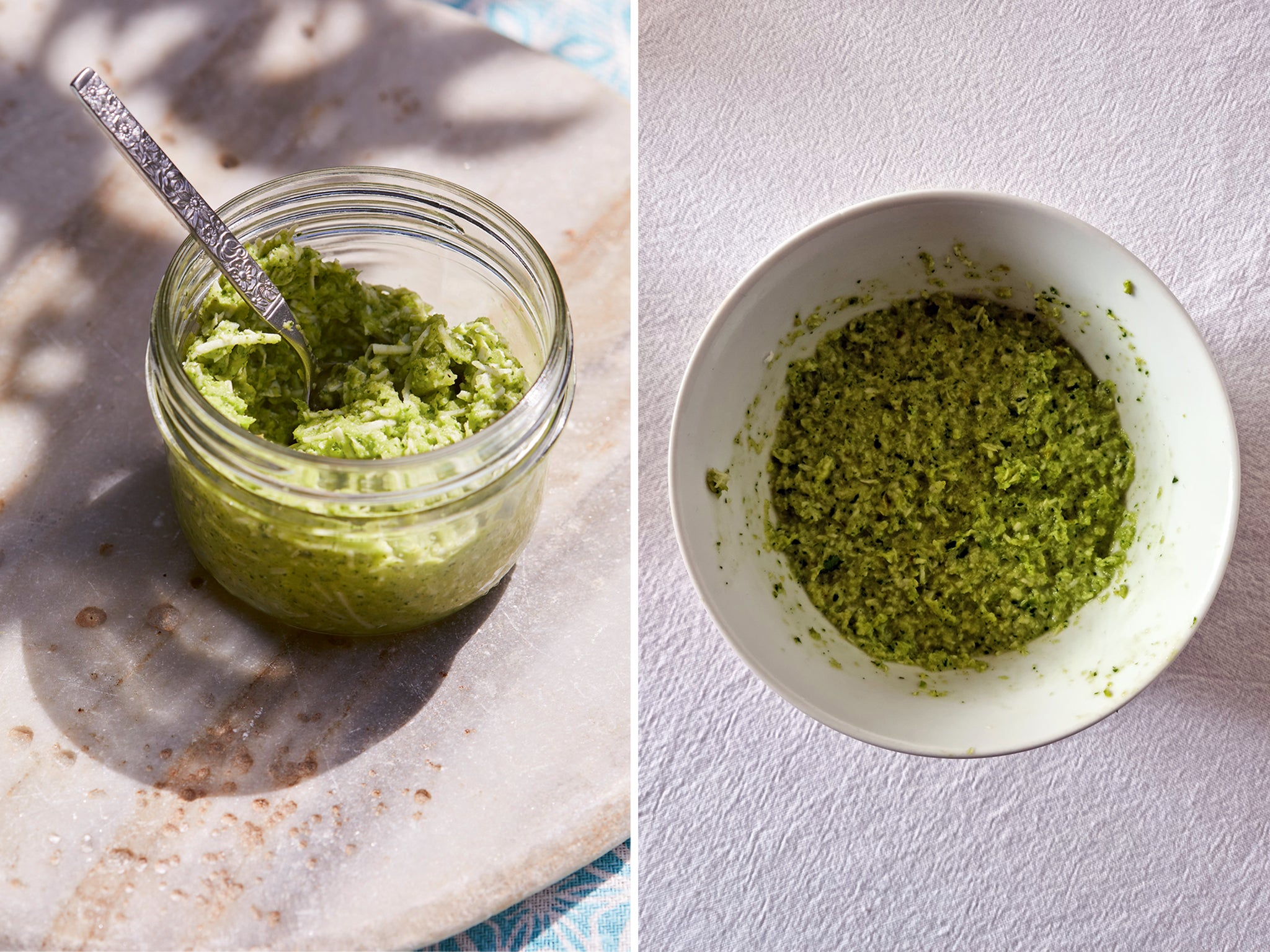
Serves: One jarful
Ingredients:
100g (3½oz) green chillies
20g (¾oz) coriander (cilantro) leaves and stems 1 small onion
1 garlic clove
3 tbsp neutral oil Juice of a lemon
1 tbsp white vinegar 1 teaspoon fine sea salt
½ tsp sugar
40g (½ cup) grated coconut or rehydrated desiccated coconut
Method:
If you like fire, leave the chilli seeds in, otherwise you can remove some of the seeds and the surrounding membrane. Roughly chop the chillies, coriander, onion and garlic. Transfer to a blender with the oil, lemon juice, vinegar, salt and sugar. Blend to a green-flecked paste.
Stir through the coconut and taste for seasoning.
This will keep in a jar in the fridge for up to 5 days and the heat will mute a little with time.
The Heinz Cookbook

Admit it – you have multiple cans of tinned food that are festering away in your cupboard… here’s where The Heinz Cookbook comes in – with over 100 recipes using the classics we know and love, dinnertime just got a whole lot more interesting. The book itself is divided into seven sections, including brunch and picnics, and uses ingredients you’re likely to have in your cupboard.
We must have been on a spice kick this month as we decided to try out the peri-peri chicken traybake. What makes this Heinz-based, you ask? Well, with the addition of baked beans, you’ve got a strange recipe that actually works really well. I was a little sceptical at first, until the finished dish came out of the oven. Apart from the courgettes (which we omitted), the ingredients come together to make a tangy dish flavoured with sweet paprika and peri-peri sauce. We used a bottle from Nando’s, so ours was on the zingier side but, as no peri-peri sauce is made equal, we’d recommend experimenting with different brands, or if you’re feeling extra creative, you could make your own.
The book is an excellent resource for using up all those tins – an estimated 2.5 million cans of Heinz Beans are sold every day and sometimes beans on toast simply won’t cut it. Recipes in the cookbook are inspired by dishes from all around the world – chorizo and prawn jambalaya using cream of tomato soup, anyone? However, don’t be expecting 100 per cent authentic recipes. I don’t think quesadillas originally had Heinz beans in them…
Flipping through The Heinz Cookbook, some recipes do seem a bit tenuous – some recipes simply call for salad cream on a salad or mayo as a condiment and that’s the only link to Heinz. However, this is not to say that every recipe is like that. There are countless different tastes and preferences that have been considered including those who live vegan and/or egg-free lifestyles. It would also make a great gift to the Heinz lover in your life.
Peri-peri chicken traybake
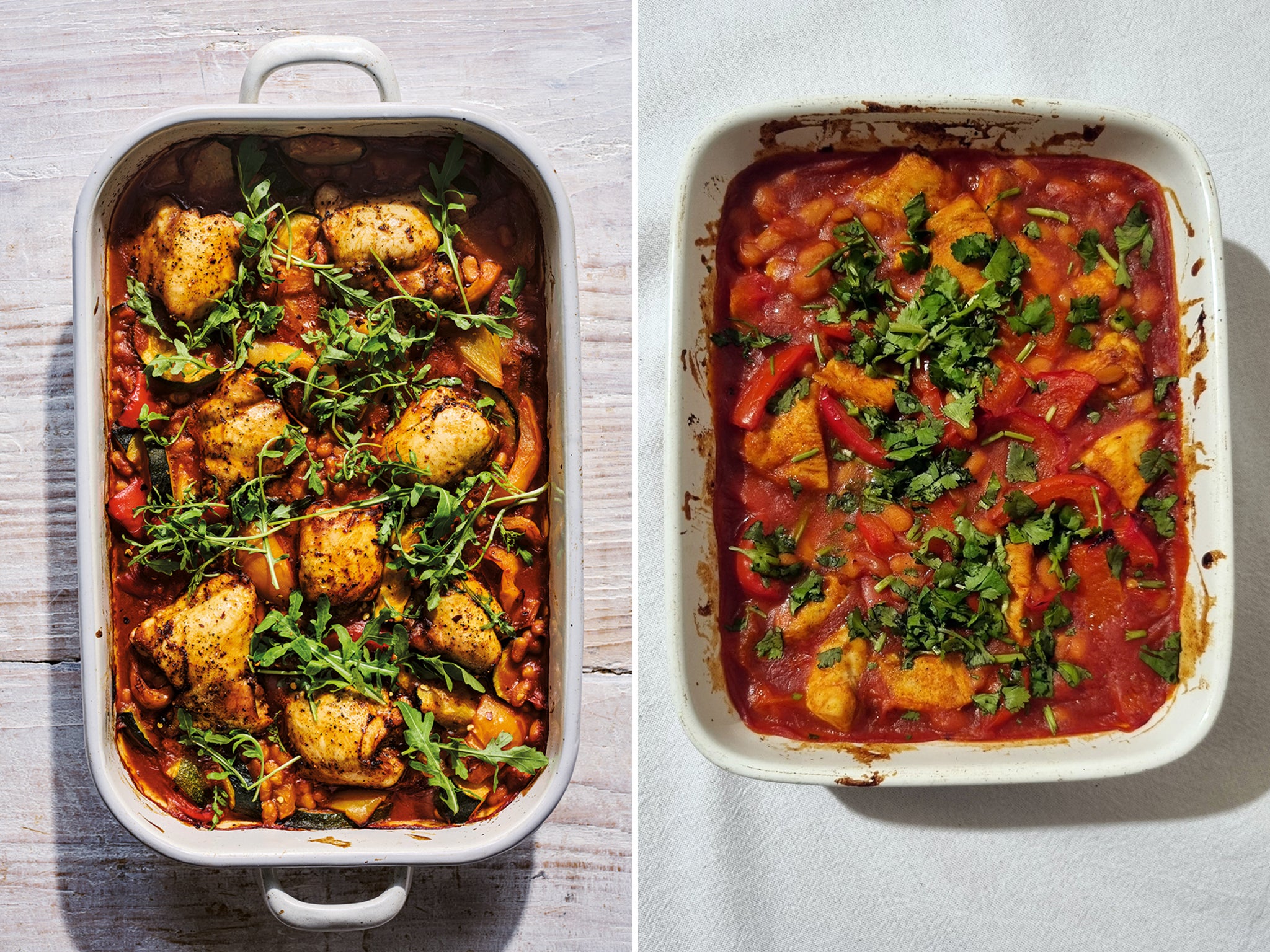
Ingredients:
8 skinless, boneless chicken thighs (about 800g in total)
3 peppers (any colour), cut into large chunks
2 courgettes, cut into large chunks
1 tbsp sweet smoked paprika
2 tbsp olive oil, plus extra to serve salt and pepper
2 x 415g tins Heinz Beanz
2 tbsp peri-peri sauce
60g rocket pinch of dried chilli flakes (optional)
Heinz [Seriously Good] Mayonnaise, to serve
Method:
Preheat the oven to 220C/200C fan/gas mark 7.
Place the chicken thighs, peppers and courgettes in a large, high-sided roasting tin. Toss with the paprika, olive oil and plenty of salt and pepper, then spread out into a single layer so that everything roasts evenly. Roast for 20 minutes.
Remove the chicken on to a plate and add the beans and peri-peri sauce to the roasting tin. Give everything a good stir and then nestle the chicken in among the beans. Return to the oven for another 15-20 minutes until the chicken is cooked through, the veg is soft and the sauce is reduced.
Scatter over the rocket, along with a sprinkling of chilli flakes, if you like, and drizzle over a little more olive oil. Bring the tin to the table for people to help themselves, and serve with mayonnaise.
The Asian Home Kitchen
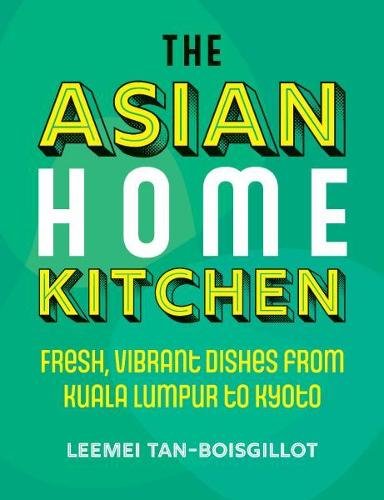
Asian cuisine can be overwhelming to start cooking up – the sheer volume of magnificent dishes out there, plus the unfamiliarity of many ingredients, can leave you feeling lost and defaulting to your local takeaway just to get food on the table. This is where blogger Leemei Tan-Boisgillot’s The Asian Home Kitchen comes in. With over 100 recipes from 11 countries, this is a comprehensive guide to Asian cooking that will have you rustling up everything from Korean bibimbap to Indonesian rendang. The book is very much a result of a life lived through food, from growing up in Kedah, Malaysia, to staying connected with her culture while travelling the world.
When writing this article I had a craving for dumplings so I was delighted to come across Tan-Boisgillot’s recipe for Japanese pork gyoza. These little meaty parcels are incredible in noodle soups or as a side snack (don’t forget to slather them in chilli oil if you can take the heat). Most of the ingredients can be found at local Asian grocery stores, in the world food aisle of big supermarkets or online. I couldn’t get my hands on shoyu, a Japanese sauce, so I just used soy sauce. The dumplings turned out amazing (if I do say so myself) – crispy and doughy on the outside and a flavour sensation on the inside.
I do have a little confession, however. My subpar baking skills and tiny kitchen meant that making the dumplings skins from scratch was a no go, so I used premade ones instead. While the best dumpling wrappers will always be handmade, premade is a great option if you just want something quick and easy. I’m excited to try more of these recipes and know I’ll be reaching for this book a lot more in the future.
Japanese pork dumplings

Ingredients:
175g/6oz white cabbage, halved and core removed
80g/2¾oz watercress, chopped
5 spring onions, finely chopped
270g/9½oz minced/ground pork
7 garlic cloves, finely chopped
2cm/¾in piece of fresh ginger, peeled and finely chopped
1 tbsp cornflour/cornstarch
1 tbsp sesame oil
3 tbsp shoyu
1 tbsp sake
1 tsp mirin
1 tsp granulated sugar
1-2 tbsp sunflower oil
freshly ground black pepper
For gyoza wrappers:
200g plain/all-purpose flour, plus extra for dusting
Sunflower oil, for oiling
Sea salt
To serve:
Shoyu
Chilli Oil
Method:
1. Bring a large saucepan of water to the boil, add the cabbage leaves and blanch for 1 minute. Remove the leaves with kitchen tongs and plunge immediately into a bowl of ice-cold water to stop the cooking process. Drain, pat dry with paper towels, squeezing out as much water as possible, and then finely chop. Transfer to a large bowl and add the watercress and spring onions.
2. Mix together the pork, garlic, ginger, cornflour, sesame oil, shoyu, sake, mirin and sugar in a large bowl until well combined and then season with pepper. Add the cabbage and watercress mix and stir to combine. Cover with cling film/plastic wrap and leave to marinate in the refrigerator for 1 hour.
3. Meanwhile, to make the gyoza wrappers, put the flour and a pinch of salt in a large mixing bowl and make a well in the centre. Slowly pour in 100ml cold water and combine with the flour to form a soft dough. Turn the dough out onto a lightly floured surface and knead for 10 minutes until it is smooth and elastic. Shape the dough into a ball, transfer to a lightly oiled bowl, cover with a damp dish towel and leave to rest for 1 hour.
4. Turn the dough out onto a lightly floured surface, roll it into a cylinder and divide into 4-5 equal portions. Take a portion of the dough and roll flat until it is about 2–3mm thick, then, using a 9cm cookie cutter, cut out neat circles. Dust the surface of the wrappers lightly with flour so they don’t stick together, then stack them on a lightly floured plate. Repeat with the remaining dough portions. Keep any dough you are not using covered with a damp dish towel to prevent it from drying out.
5. Have a small bowl of water by the side to use for sealing the dumplings. Place a gyoza wrapper on the forefront of your hand, then put a heaped tablespoon of the pork filling in the centre. Shape the filling into an oblong shape and flatten it slightly. Wet around the edge of the wrapper with water and bring one side of the wrapper over the filling to form a half-moon shape.
6. Press one corner of the wrapper together to seal, then pinch the edge of the top half of the wrapper next to the seal into a pleat, pushing the pleat into the edge of the bottom half of the wrapper to seal. Continue to work around the edge to the other corner. There should be 6-8 pleats and the bottom half of the wrapper should remain flat.
7. When you’ve finished pleating the pastry, press gently into the back of the pastry to form a crescent shape. Transfer the gyoza to a lightly floured plate and cover with a damp dish towel while you make the remaining dumplings.
8. Heat the sunflower oil in a large frying pan over a medium-high heat, then arrange the gyoza in the pan. Leave a bit of space between each dumpling to avoid the gyoza sticking together. Cook for 3-4 minutes, then pour in enough hot water to half cover the gyoza. Cover and cook over a medium heat until the liquid has evaporated.
9. Remove the lid and cook for a further 4-5 minutes, or until the bottom of the gyoza becomes brown and crisp. Depending on the size of the frying pan, you may need to cook the gyoza in batches. Serve immediately with shoyu and chilli oil, if you like.
The Levantine Table
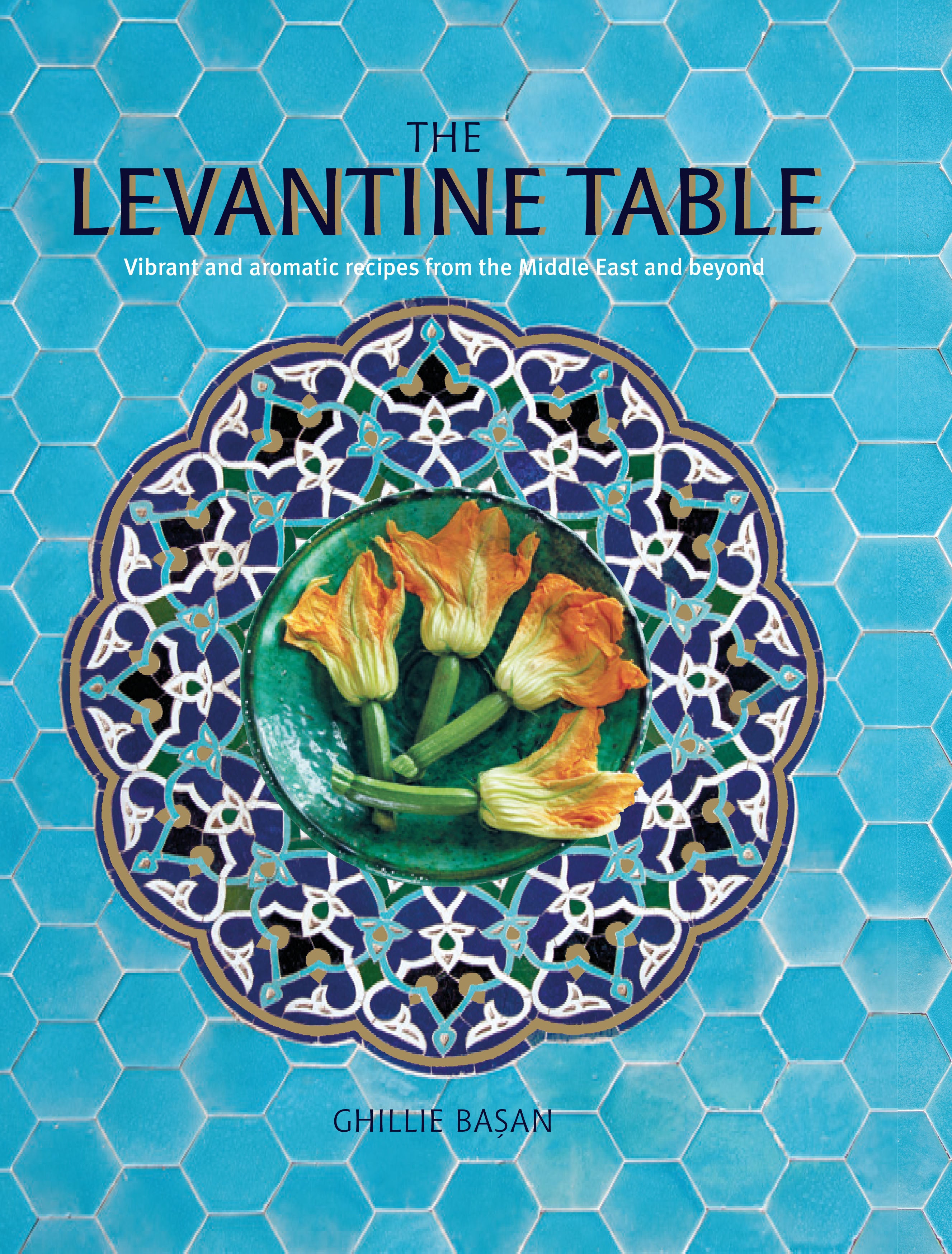
Our fifth and final cookbook is The Levantine Table by writer and food anthropologist Ghillie Basan. This wonderful collection collects recipes from the Levant, a region of the Middle East that stretches along the shores of the eastern Mediterranean. Similarly to The Nutmeg Trail, this book celebrates the rich history of the region and the sheer number of recipes to have become part of the cuisine. There are many incredible dishes (think grilled meats with plenty of vegetables and spice), however where this book really shines is in the mezze section. Whether you’re after classics such as tabbouleh and feta-based dishes or something fancier, such as labna with saffron and pistachios, there’s something in here to wow at your next dinner party.
When it came to testing, it was a toss up between chicken, onions and sumac pitta or hummus with pine nuts and chilli butter. We were in need of a dip, so we went with the former. The dish, known as sicak humus in Turkish, is a wonderful blend of spicy and creamy, thanks in part to the addition of thick yoghurt into the mix. The roasted pine nuts on top added a really nice crunch every time we slathered out pitta with the dip. This would also work really nicely with some sweet chilli crisps, if you were inclined to make your snacking into a fancy affair.
One of the good things about this book is that many of the ingredients listed are used in multiple recipes, meaning there’s no need to keep forking out for obscure items and you can cut down on food waste as well. Sandwiched in between recipes are really handy guides to traditional cooking methods such as roasting and chargrilling.
Hot hummus with pine nuts and chilli butter

Ingredients:
2 x 400g cans chickpeas, drained and thoroughly rinsed
2 tsp cumin seeds
2-3 garlic cloves, crushed
Roughly 4 tbsp olive oil
Freshly squeezed juice of 2 lemons
2 tbsp tahini
500 ml creamy yoghurt
Sea salt and freshly ground
Black pepper
2 tbsp pine nuts
50g/3 tbsp butter
Red chilli
Warm crusty bread, to serve
Method:
Preheat the oven to 200°C (400°F) Gas 6. Instead of using a pestle and mortar to pound the chickpeas to a paste in the traditional manner, make life easy and tip the chickpeas into an electric blender. Add the cumin seeds, garlic, olive oil and lemon juice and whizz the mixture to a thick paste. Add the tahini and continue to blend until the mixture is really thick and smooth.
Add the yoghurt and whizz until the mixture has loosened a little and the texture is creamy. Season generously with salt and pepper and tip the mixture into an ovenproof dish.
Roast the pine nuts in a small frying pan/skillet until they begin to brown and emit a nutty aroma. Add the butter to the pine nuts and stir until it melts. Stir in the chopped chilli/chile and pour the melted butter over the hummus, spooning the pine nuts all over the surface.
Pop the dish into the preheated oven for about 25 minutes, until the hummus has risen a little and most of the butter has been absorbed. Serve immediately with chunks of warm crusty bread.
Nectar of the Gods: From Hera’s Hurricane to the Appletini of Discord, 75 Mythical Cocktails to Drink Like a Deity by Liv Albert and Thea Engst (Simon and Schuster, £12.99); The Nutmeg Trail by Eleanor Ford (Murdoch Books, £26); The Heinz Cookbook (Ebury Press, £20); The Levantine Table by Ghillie Basan (Ryland, Peters & Small, £25) is out 28 June; The Asian Home Kitchen: Fresh, vibrant dishes from Kuala Lumpur to Kyoto by Leemei Tan-Boisgillot (Nourish, £20) is out 14 June.
Join our commenting forum
Join thought-provoking conversations, follow other Independent readers and see their replies
Comments
Bookmark popover
Removed from bookmarks